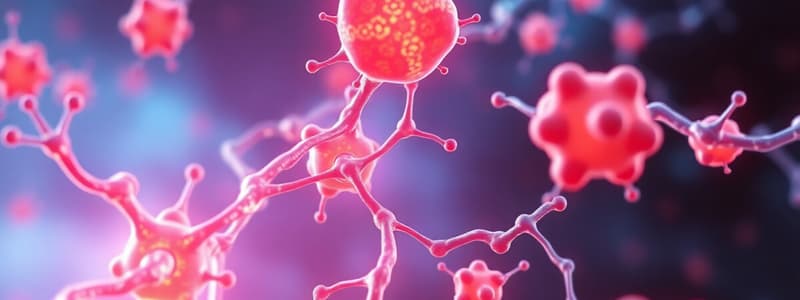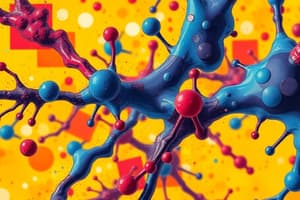Podcast
Questions and Answers
Which receptor is primarily responsible for bronchodilation when stimulated by sympathomimetic drugs?
Which receptor is primarily responsible for bronchodilation when stimulated by sympathomimetic drugs?
- β1 receptors
- β2 receptors (correct)
- α2 receptors
- α1 receptors
What side effect is commonly associated with the use of sympathomimetic drugs?
What side effect is commonly associated with the use of sympathomimetic drugs?
- Drowsiness
- Tachycardia (correct)
- Bradycardia
- Hypotension
In the treatment of Anaphylaxis, which sympathomimetic drug is primarily utilized?
In the treatment of Anaphylaxis, which sympathomimetic drug is primarily utilized?
- Phenylephrine
- Dobutamine
- Amphetamines
- Epinephrine (correct)
What mechanism of action is characterized by sympathomimetic drugs that directly stimulate adrenergic receptors?
What mechanism of action is characterized by sympathomimetic drugs that directly stimulate adrenergic receptors?
Which type of sympathomimetic drug increases norepinephrine release or inhibits its reuptake?
Which type of sympathomimetic drug increases norepinephrine release or inhibits its reuptake?
Which of the following drug interactions increases the risk of hypertensive crisis with sympathomimetics?
Which of the following drug interactions increases the risk of hypertensive crisis with sympathomimetics?
Which sympathomimetic is specifically indicated for nasal decongestion?
Which sympathomimetic is specifically indicated for nasal decongestion?
What adverse effect is prominently linked to increased gluconeogenesis by sympathomimetic drugs?
What adverse effect is prominently linked to increased gluconeogenesis by sympathomimetic drugs?
What is a characteristic feature of mixed-acting sympathomimetics?
What is a characteristic feature of mixed-acting sympathomimetics?
Which adrenergic receptor subtype is associated with sedation when stimulated?
Which adrenergic receptor subtype is associated with sedation when stimulated?
Flashcards are hidden until you start studying
Study Notes
Sympathomimetic Drugs
Mechanism Of Action
- Mimic the effects of endogenous catecholamines (epinephrine, norepinephrine).
- Act primarily on adrenergic receptors (α and β receptors).
- α1 receptors: Vasoconstriction, increased peripheral resistance.
- α2 receptors: Inhibition of neurotransmitter release, sedation.
- β1 receptors: Increased heart rate and contractility.
- β2 receptors: Bronchodilation, vasodilation, and uterine relaxation.
Side Effects
- Cardiovascular: Hypertension, tachycardia, arrhythmias.
- Central Nervous System: Anxiety, tremors, insomnia.
- Gastrointestinal: Nausea, vomiting, decreased appetite.
- Metabolic: Hyperglycemia due to increased gluconeogenesis.
- Potential for tolerance and dependence with prolonged use.
Clinical Uses
- Asthma and COPD (β2 agonists): Albuterol, salmeterol for bronchodilation.
- Cardiovascular (β1 agonists): Dobutamine for heart failure and shock.
- Nasal decongestion (α1 agonists): Phenylephrine, oxymetazoline.
- Anaphylaxis (epinephrine): Emergency treatment for severe allergic reactions.
- Attention Deficit Hyperactivity Disorder (ADHD): Amphetamines as stimulants.
Drug Interactions
- Monoamine oxidase inhibitors (MAOIs): Increased risk of hypertensive crisis.
- Tricyclic antidepressants: Potentiate sympathomimetic effects.
- Beta-blockers: May reduce effectiveness of β agonists.
- Other stimulants: Cumulative cardiovascular effects may occur.
Types Of Sympathomimetics
-
Direct-acting sympathomimetics
- Directly stimulate adrenergic receptors (e.g., epinephrine, norepinephrine).
-
Indirect-acting sympathomimetics
- Increase the release of norepinephrine or inhibit its reuptake (e.g., amphetamines).
-
Mixed-acting sympathomimetics
- Have both direct and indirect effects (e.g., ephedrine).
-
Selective sympathomimetics
- Target specific adrenergic receptor subtypes (e.g., phenylephrine for α1).
This structured overview provides a concise understanding of sympathomimetic drugs, highlighting their mechanisms, uses, and important considerations.
Mechanism of Action
- Sympathomimetic drugs imitate endogenous catecholamines like epinephrine and norepinephrine.
- They predominantly act on adrenergic receptors, which are divided into:
- α1 receptors: Induce vasoconstriction and elevate peripheral resistance.
- α2 receptors: Inhibit neurotransmitter release, resulting in sedation.
- β1 receptors: Enhance heart rate and myocardial contractility.
- β2 receptors: Facilitate bronchodilation, vasodilation, and relaxation of uterine muscles.
Side Effects
- Cardiovascular: Possible side effects include hypertension, tachycardia, and arrhythmias.
- Central Nervous System: May cause anxiety, tremors, and insomnia.
- Gastrointestinal: Can lead to nausea, vomiting, and decreased appetite.
- Metabolic: Hyperglycemia may occur from increased gluconeogenesis.
- Prolonged use can result in tolerance and potential dependence.
Clinical Uses
- Asthma and COPD: β2 agonists such as albuterol and salmeterol are used for bronchodilation.
- Cardiovascular Issues: Dobutamine, a β1 agonist, is utilized in heart failure and shock management.
- Nasal Decongestion: α1 agonists like phenylephrine and oxymetazoline facilitate relief.
- Anaphylaxis: Epinephrine is critical for the emergency treatment of severe allergic reactions.
- ADHD: Amphetamines function as stimulants for attention deficit hyperactivity disorder.
Drug Interactions
- MAOIs: Co-use heightens the risk of hypertensive crises.
- Tricyclic Antidepressants: These can amplify the effects of sympathomimetics.
- Beta-blockers: May diminish the effectiveness of β agonists.
- Other Stimulants: Potential for cumulative cardiovascular effects may arise.
Types of Sympathomimetics
- Direct-acting: Stimulate adrenergic receptors directly (e.g., epinephrine, norepinephrine).
- Indirect-acting: Promote the release of norepinephrine or block its reuptake (e.g., amphetamines).
- Mixed-acting: Exhibit both direct and indirect mechanisms (e.g., ephedrine).
- Selective: Specifically target certain adrenergic receptor subtypes (e.g., phenylephrine for α1 receptors).
Studying That Suits You
Use AI to generate personalized quizzes and flashcards to suit your learning preferences.




